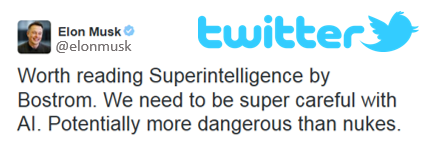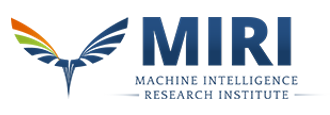Don’t fear artificial intelligence | by Ray Kurzweil
December 30, 2014 by Ray Kurzweil
 Ray Kurzweil responds to concerns from Elon Musk and Stephen Hawking, Phd, on the future possibility of dangers from developments in artificial intelligence. This was also published in Time magazine’s Ideas section.
Ray Kurzweil responds to concerns from Elon Musk and Stephen Hawking, Phd, on the future possibility of dangers from developments in artificial intelligence. This was also published in Time magazine’s Ideas section.
related reading:
Time | “Don’t fear artificial intelligence” by Ray Kurzweil
Don’t fear artificial intelligence
by Ray Kurzweil
Stephen Hawking, the pre-eminent physicist, recently warned that artificial intelligence (AI), once it surpasses human intelligence, could pose a threat to the existence of human civilization.
Elon Musk, the pioneer of digital money, private spaceflight and electric cars, has voiced similar concerns.
If AI becomes an existential threat, it won’t be the first one. Humanity was introduced to existential risk when I was a child sitting under my desk during the civil defense drills of the 1950s.
Since then we have encountered comparable specters, like the possibility of a bioterrorist creating a new virus for which humankind has no defense. Technology has always been a double edged sword, since fire kept us warm but also burned down our villages.
The typical dystopian futurist movie has one or two individuals or groups fighting for control of “the AI.” Or we see the AI battling the humans for world domination. But this is not how AI is being integrated into the world today. AI is not in one or two hands, it’s in 1 billion or 2 billion hands.
A kid in Africa with a smartphone has more intelligent access to knowledge than the President of the United States had 20 years ago. As AI continues to get smarter, its use will only grow. Virtually everyone’s mental capabilities will be enhanced by it within a decade.
We will still have conflicts among groups of people, each enhanced by AI. That is already the case. But we can take some comfort from a profound, exponential decrease in violence, as documented in Steven Pinker’s 2011 book, The Better Angels of Our Nature: Why Violence Has Declined. According to Pinker, although the statistics vary somewhat from location to location, the rate of death in war is down hundredsfold compared with six centuries ago.
Since that time, murders have declined tensfold. People are surprised by this. The impression that violence is on the rise results from another trend: exponentially better information about what is wrong with the world — another development aided by AI.
There are strategies we can deploy to keep emerging technologies like AI safe. Consider biotechnology, which is perhaps a couple of decades ahead of AI. A meeting called the Asilomar Conference on Recombinant DNA was organized in 1975 to assess its potential dangers and devise a strategy to keep the field safe.
The resulting guidelines, which have been revised by the industry since then, have worked very well: there have been no significant problems, accidental or intentional, for the past 39 years. We are now seeing major advances in medical treatments reaching clinical practice and thus far none of the anticipated problems.

Short story “Runaround” by Isaac Asimov, included in the collection Robot Visions, features AI woven into daily life. In agreement with Kurzweil, Isaac Asimov said, “Science fiction may seem trivial to blind critics and philosophers of today — but the core of science fiction has become crucial to our salvation if we are to be saved at all. I do not fear computers, I fear the lack of them.”
Consideration of ethical guidelines for AI goes back to Isaac Asimov’s Three Laws of Robotics, which appeared in his short story “Runaround” in 1942, eight years before Alan Turing introduced the field of AI in his 1950 paper “Computing Machinery and Intelligence.”
The median view of AI practitioners today is that we are still several decades from achieving human level AI. I am more optimistic and put the date at 2029, but either way, we do have time to devise ethical standards.
There are efforts at universities and companies to develop AI safety strategies and guidelines, some of which are already in place. Similar to the Asilomar guidelines, one idea is to clearly define the mission of each AI program and to build in encrypted safeguards to prevent unauthorized uses.
Ultimately, the most important approach we can take to keep AI safe is to work on our human governance and social institutions. We are already a human machine civilization.
The best way to avoid destructive conflict in the future is to continue the advance of our social ideals, which has already greatly reduced violence.
AI today is advancing the diagnosis of disease, finding cures, developing renewable clean energy, helping to clean up the environment, providing high quality education to people all over the world, helping the disabled — including providing Hawking’s voice — and contributing in a myriad of other ways.
We have the opportunity in the decades ahead to make major strides in addressing the grand challenges of humanity. AI will be the pivotal technology in achieving this progress. We have a moral imperative to realize this promise while controlling the peril. It won’t be the first time we’ve succeeded in doing this.
related reading: artificial intelligence futures
AAAI | AAAI presidential panel on long term AI futures 2008-2009 study: report
Microsoft Research | Asilomar meeting on long term AI futures: report
Microsoft Research | Asilomar study on long term AI futures highlights: report
Microsoft Research | Eric Horvitz, PhD
Stanford University | “Stanford to host 100 year study on artificial intelligence”
Stanford University | “100 year study of artificial intelligence: reflections and framing” by Eric Horvitz, PhD
Stanford University | “What is artificial intelligence: basics, branches and applications of AI” by John McCarthy, PhD
![]()


related reading: artificial intelligence discussion
The New York Times | “Century long study will examine effects of artificial intelligence”
The New York Times | “Artificial intelligence as a threat”
The New York Times | “The future is now? Pretty soon, at least — futurist Ray Kurzweil sees a revolution fueled by information technology”
Fox News | “Elon Musk says we are summoning the demon with artificial intelligence”
Fox News | “Could artificial intelligence be humanity’s biggest threat”: video
CNBC | “AI potentially more dangerous than nukes, Musk warns”
CNBC | “Stephen Hawking warns AI threatens mankind”
The Wall Street Journal | “The future of AI: a ubiquitous, invisible, smart utility”
Discovery News | “Ten ways artificial intelligence will affect our lives”
 related books:
related books:
book | The Better Angels of Our Nature: Why Violence Has Declined by Steven Pinker, PhD
book | Superintelligence: Paths, Dangers, Strategies by Nick Bostrom, PhD
in the news: Twitter post by Elon Musk sparked debate about AI’s growing power

related reading: guidelines for artificial intelligence
Machine Intelligence Research Institute | main
Institute for Ethics and Emerging Technologies | main
Wikipedia | Ethics of artificial intelligence
Wikipedia | Three Laws of Robotics

Three Laws of Robotics devised by the science fiction author Isaac Asimov. These rules are software programs he intended to be coded into robots to give them human level ethics and guidelines for behavior.(credit: Frame It)


